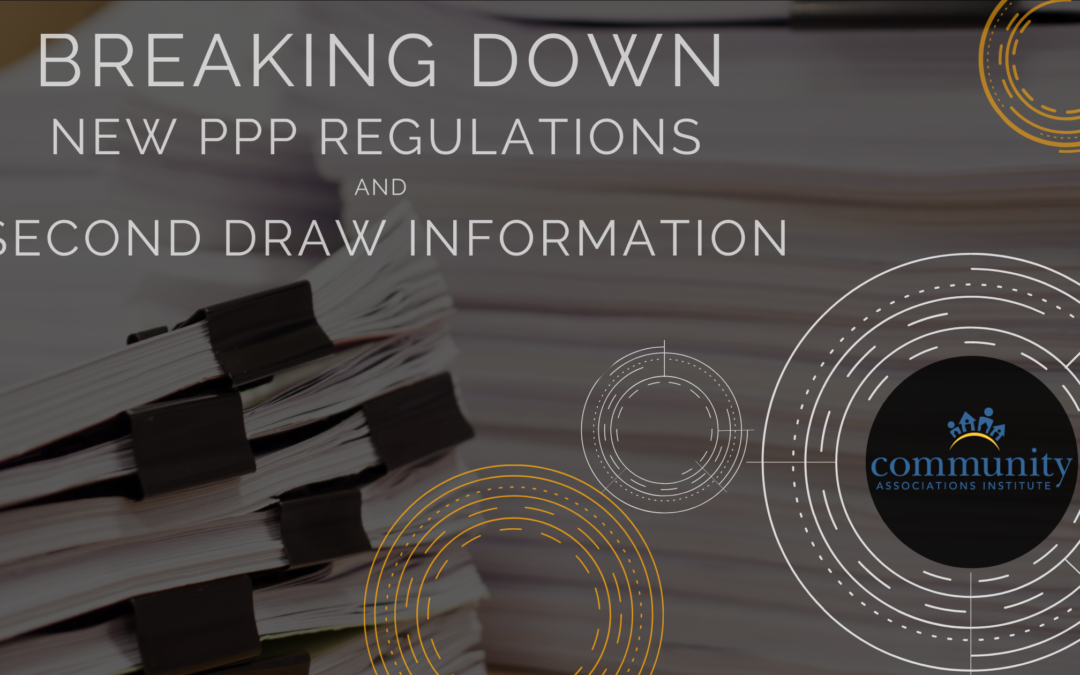The Small Business Administration and U.S. Treasury Department released new regulations on the expanded Paycheck Protection Program (PPP) as amended through the “Economic Aid to Hard-Hit Small Businesses, Nonprofits, and Venues Act.” The new regulations expand eligibility to housing cooperatives and 501(c)(6) organizations, like CAI chapters, and provide for a Second Draw PPP Loan to eligible borrowers.
CAI is currently reviewing the new regulations to see how it will impact our members. The previous guidance CAI published in December remains an accurate source of information.
The rules can be found here:
Alan Gassman, a Florida attorney, provided a breakdown of the PPP regulations in a recent Forbes article. Here are some highlights.
Second Draws
The Interim Final Rules clarify that:
-
- The borrower must have spent the full amount of its First Draw PPP Loan on eligible expenses under the PPP rules to be eligible for a Second Draw PPP Loan; and
- “The full amount” of the borrower’s First Draw PPP Loan includes the amount of any increase on such First Draw PPP Loan made pursuant to the Economic Aid Act.
“Gross Receipts” Defined for Purposes of Determining Whether There Has Been a 25% Drop in Revenues to Qualify for Second Draw:
The Economic Aid Act does not include a general definition of “gross receipts” for purposes of determining a borrower’s revenue reduction.
The Interim Final Rules provide that gross receipts include the following:
-
- “All revenue in whatever form received or accrued (in accordance with the entity’s accounting method) from whatever source, including from the sales of products or services, interest, dividends, rents, royalties, fees, or commissions, reduced by returns and allowances.”
The Interim Final Rules provide that gross receipts do not include the following:
-
- “Taxes collected for and remitted to a taxing authority if included in gross or total income (such as sales or other taxes collected from customers and excluding taxes levied on the concern or its employees);
- Proceeds from transactions between a concern and its domestic or foreign affiliates; and
- Amounts collected for another by a travel agent, real estate agent, advertising agent, conference management service provider, freight forwarder or customs broker.”
Expanded Eligibility for Housing Cooperatives
Housing cooperatives (as defined in section 216(b) of the Internal Revenue Code of 1986) that employ not more than 300 employees are eligible to apply for PPP loans as long as other eligibility requirements are met.
Expanded Eligibility for 501(c)(6) Organizations
Organizations that are classified as a 501(c)(6) will have expanded eligibility to PPP loans. A 501(c)(6) is defined as follows:
(6) Business leagues, chambers of commerce, real-estate boards, boards of trade, or professional football leagues (whether or not administering a pension fund for football players), not organized for profit and no part of the net earnings of which inures to the benefit of any private shareholder or individual.
Regarding 501(c)(6) eligibility, the Act states the following:
IN GENERAL.—Except as provided in subclause (II), any organization that is described in section 501(c)(6) of the Internal Revenue Code and that is exempt from taxation under section 501(a) of such Code (excluding professional sports leagues and organizations with the purpose of promoting or participating in a political campaign or other activity) shall be eligible to receive a covered loan if— 5(aa) the organization does not receive more than 15 percent of its receipts from lobbying activities;
(bb) the lobbying activities of the organization do not comprise more than 15 percent of the total activities of the organization; and
(cc) the organization employs not more than 300 employees.
Key Eligible Expenses
It is important to note the Paycheck Protection Program (PPP) is intended to cover payroll expenses for eligible entities to keep workers paid and employed. The recent Economic Aid Act expanded the list of eligible expenses. However, it is important to note that 60 percent of the PPP loan proceeds shall be used for payroll costs. For purposes of loan forgiveness, the borrower will have to document the proceeds used for payroll costs in order to determine the amount of forgiveness.
The proceeds of a PPP loan are to be used for:
- payroll costs (as defined in the CARES Act, Economic Aid Act and this interim final rule);
- costs related to the continuation of group health care, life, disability, vision, or dental benefits during periods of paid sick, medical, or family leave, and group health care, life, disability, vision, or dental insurance premiums;
- mortgage interest payments (but not mortgage prepayments or principal payments);
- rent payments;
- utility payments;
- interest payments on any other debt obligations that were incurred before February 15, 2020;
- refinancing an SBA EIDL loan made between January 31, 2020 and April 3, 2020;
- covered operations expenditures (payments for any business software or cloud computing service that facilitates business operations, product or service delivery, the processing, payment, or tracking of payroll expenses, human resources, sales and billing functions, or accounting or tracking of supplies, inventory, records and expenses);
- covered property damage costs (costs related to property damage and vandalism or looting due to public disturbances that occurred during 2020 that was not covered by insurance or other compensation);
- covered supplier costs (expenditures made by a borrower to a supplier of goods for the supply of goods.
- covered worker protection expenditures ((A) operating or capital expenditures to facilitate the adaptation of the business activities of an entity to comply with requirements established or guidance issued by the Department of Health and Human Services, the Centers for Disease Control, or the Occupational Safety and Health Administration.
To see all COVID-19 government actions impacting community associations, click here



